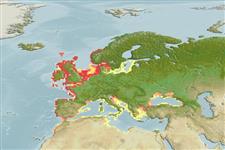>
Eupercaria/misc (Various families in series Eupercaria) >
Labridae (Wrasses)
Etymology: Ctenolabrus: Greek, kteis, ktenos = comb + Greek, labros = furious (Ref. 45335).
More on author: Linnaeus.
Environment: milieu / climate zone / depth range / distribution range
पारिस्थितिकी
समुद्री प्रवाल-भित्ति संयुक्त; गहराई सीमा 1 - 50 m, usually 1 - 20 m (Ref. 35388). Temperate; 64°N - 30°N, 11°W - 42°E
Eastern Atlantic: Norway to Morocco. Also known from the Mediterranean and Black Sea.
आकार / वज़न / Age
Maturity: Lm ? range ? - ? cm
Max length : 18.0 cm TL पुल्लिंग / अलिंग; (Ref. 3397); common length : 11.0 cm TL पुल्लिंग / अलिंग; (Ref. 3397); अधिकतम सूचित उम्र: 8 वर्षो (Ref. 4742)
Dark spot on caudal peduncle and front end of dorsal fin (Ref. 35388).
On rocky, weed-covered shores (1-50 m); larger specimens deeper than young. Feed on bryozoans, crustaceans and gastropods (Ref. 3397). Spawning takes place in summer when the male defends a territory (Ref. 35388). Used in salmon culture as cleaner fish (Helmut Tethmeyer, pers. comm.).
Also Ref. 103751.
Bauchot, M.-L., 1987. Poissons osseux. p. 891-1421. In W. Fischer, M.L. Bauchot and M. Schneider (eds.) Fiches FAO d'identification pour les besoins de la pêche. (rev. 1). Méditerranée et mer Noire. Zone de pêche 37. Vol. II. Commission des Communautés Européennes and FAO, Rome. (Ref. 3397)
IUCN Red List Status (Ref. 130435)
Threat to humans
Harmless
Human uses
मात्स्यिकी: निर्वाह मात्स्यिकी; आखेट मत्स्य: हां; जलजीवालय: सार्वजनिक लजीवालय
साधन
Special reports
Download XML
इंटरनेट स्रोत
Estimates based on models
Preferred temperature (Ref.
123201): 8.7 - 15, mean 10.4 °C (based on 380 cells).
Phylogenetic diversity index (Ref.
82804): PD
50 = 1.0000 [Uniqueness, from 0.5 = low to 2.0 = high].
Bayesian length-weight: a=0.00955 (0.00456 - 0.02002), b=3.06 (2.89 - 3.23), in cm total length, based on LWR estimates for this (Sub)family-body shape (Ref.
93245).
Trophic level (Ref.
69278): 3.6 ±0.2 se; based on diet studies.
लौटाव (Ref.
120179): माध्यम, न्यूनतम जनसंख्या दुगनी होने का समय 1.4 - 4.4 वर्ष। (K=0.30-0.41; tmax=8; tm=2).
Fishing Vulnerability (Ref.
59153): Low to moderate vulnerability (33 of 100).
Climate Vulnerability (Ref.
125649): Low vulnerability (16 of 100).
Nutrients (Ref.
124155): Calcium = 23.4 [9.8, 44.1] mg/100g; Iron = 0.219 [0.117, 0.469] mg/100g; Protein = 18.7 [15.8, 20.9] %; Omega3 = 0.411 [0.217, 0.794] g/100g; Selenium = 5.58 [2.50, 12.60] μg/100g; VitaminA = 109 [26, 541] μg/100g; Zinc = 0.778 [0.494, 1.400] mg/100g (wet weight);
